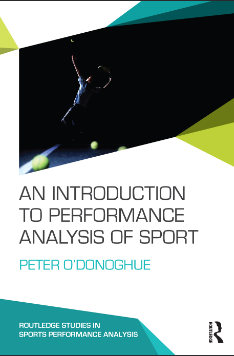between live during-match analysis and post-match analysis. The final question is ‘How?’ This is answered by introducing the main manual and computerised methods that will be covered in detail later in the book. Another way of phrasing the question ‘What?’ is by asking ‘What should be analysed?’ Specifically, what are the purposes of using sports perform- ance analysis and what aspects of sports performance can be analysed. There are many different purposes of sports performance analysis includ- ing analysis of players, teams, coach behaviour and referees (O’Donoghue, 2010: 4–5). The purposes include work-rate analysis (Carling and Bloomfield, 2013), tactical analysis (Hibbs and O’Donoghue, 2013), effectiveness of chosen techniques (Palao and Morante, 2013) and analysis of technique (Lees, 2008; Campos, 2013). Academic investiga- tions are done into factors influencing sports performance (Taylor et al., 2008; Gomez et al., 2013). There are also judging (Kirkbride, 2013a) and media (James, 2008; Kirkbride, 2013b) applications of sports performance analysis. This chapter includes a section on two main purposes of sports performance analysis that will be used throughout this book; work-rate analysis and match analysis. The match analysis purpose combines tacti- cal analysis with analysing the effectiveness of skills. This is because tactical choices can be evaluated by how effectively they are applied. SPORTS PERFORMANCE ANALYSIS: WHAT? WHY? WHO? WHERE? WHEN? AND HOW? What is sports performance analysis? This is the first of three subsections asking the question ‘What?’ in rela- tion to sports performance analysis; what is sports performance analysis, what are the purposes of sports performance analysis and what variables should be analysed? In considering what sports performance analysis is, we are considering the nature of the sports performance analysis in prac- tice as well as the academic discipline. The main thing that distinguishes sports performance analysis from other disciplines of sports science is that actual performance is analysed. This is usually done through observation of the performance which could be live or post-competition if it has been video recorded. Sports perform- ance analysis would typically not include either of the following: what is sports performance analysis?2 � Self-report studies such as interviews, focus groups or questionnaires that explore general motives, intentions, attitudes and beliefs about sport. � Laboratory experiments, field experiments or testing. However, O’Donoghue (2010: 2) proposed that self-report and laboratory methods could be included within the scope of sports performance analy- sis under certain conditions. Any data coming from actual sports performance allows studies to fall within the broad scope of sports performance analysis. Such data are not limited to observational data. The data can include qualitative data, quantitative data, notation, video sequences, measurement, heart-rate responses, perceived exertion, blood lactate measures, EEG (electroencephalography) measures and EMG (electromyography) measures. Measurements of acceleration and location are possible during sports performance. Location can be sampled at 10Hz or greater by devices that can be worn by players during training and that are permitted during competition in some sports. There are thoughts and decision making processes that occur during actual sports performance that cannot be directly observed but which are relevant aspects of sports performance. Where an athlete observes a recording of their performance, reflecting on it and discusses the thoughts they had and decisions they made during the performance, interview data allow this aspect of performance to be studied (Poziat et al., 2010). This is a different use of self-report techniques to their traditional use in researching general atti- tudes and beliefs. It is an innovative use of interviews, focus groups, accounts or other self-report methods to investigate the experience of actual sports performance. There is a case to be made for some controlled laboratory experiments falling within the scope of sports performance analysis. Analysis of tech- nique has been done using biomechanics methods (Bartlett, 1999; Lees, 2008). Although many biomechanics investigations are done away from actual competition and training, biomechanics techniques have long been recognised as being within the scope of performance analysis (Hughes and Bartlett, 2004, 2008). Technique is an important aspect of sport, espe- cially in cyclic sports activities such as running, swimming, cycling and walking (Marinho et al., 2013) as well as explosive sports such as field events in athletics (Campos, 2013). Lees (2008) classified skills as event skills, major skills and minor skills. Event skills constitute the entire event being performed such as the long jump. Major skills are dominant what is sports performance analysis? 3 Like That!’). One of the interesting sections in this video was the cover- age of the home qualifying match against Poland. The video interleaved excerpts from a training session prior to this match with footage from the actual match which England won by three goals to nil. In one part, it shows the head coach, Graham Taylor, warning that Poland’s defence was vulnerable when dealing with crosses and that crosses should be played in early to England’s centre forward, Les Ferdinand. The squad were shown playing crosses in training with forwards running into the penalty area to head the ball towards goal. Then the video showed where this was successfully done in the match with Les Ferdinand heading a goal from a cross. Another part showed Paul Gascoigne, Stuart Pearce and Graham Taylor discussing a way of taking a free kick if Poland set up a defensive wall. This was rehearsed in training and the programme also showed this type of free kick being used by Stuart Pearce to score a goal in the match. These are examples of feed-forward, because they allow areas of performance to be analysed before the match and decisions to be made about how to play. These decisions may involve abandoning tactics that the team cannot perform successfully, or selecting players who can effectively implement the tactics that have been rehearsed. In an academic context, sports performance analysis is used to research many areas of sports performance. There are investigations that use exclusively observational methods, while others use sports performance analysis as part of a multi-disciplinary investigation allowing use of complementary methods. Examples of studies that have used comput- erised notational analysis along with qualitative techniques include some studies of coach behaviour that have been done using the Arizona State University Observation Instrument (ASUOI) (Lacy and Darst, 1984, 1985, 1989). One study of netball coach behaviour used the ASUOI to compare coaches of different levels and then presented these results to an expert coach who was interviewed about the differences between coaches of different levels (Donnelly and O’Donoghue, 2008). Another example of sport performance analysis being used with other methods was a trian- gulation of computerised time-motion analysis of netball performance, psychological inventory and interviews (Hale, 2004). Hale compared competitive matches with training matches played by seven players using computerised time-motion analysis, having asked the players to complete the DM-CSAI2 questionnaire before the matches. After the matches, play- ers were interviewed about the experiences of playing in training and competitive matches. what is sports performance analysis? 5 well they have been performed according to outcome. This broadly clas- sifies skills as being performed positively or negatively without analysing the detail of the technical movement. Technical effectiveness can be expressed in terms of the percentage of skills that are performed success- fully, such as pass completion rates in team games or service rates in racket sports. For example, a player may complete 80 per cent of short passes and 64 per cent of long passes. Note, that we have not considered any detail of the passing technique when broadly looking at the effec- tiveness of passing. Similarly, a tennis player may win 65 per cent of service points when a flat serve is used, 60 per cent when a kick serve is used and 55 per cent when a slice serve is used. Again, no detail of the service techniques involved here has been described. The analysis of technical effectiveness can direct the use of more detailed analysis of technique (Bartlett, 2002). For example, we may decide to examine the player’s kick serve which we have found to be the least productive in winning points. This involves looking at the kick serve technique in detail. The soccer example is not as straightforward as completing 64 per cent of long passes may be a better performance than completing 80 per cent of short passes. If two short passes are equivalent to a long pass, then the chance of two successive short passes being successful is 80 per cent of 80 per cent which is 64 per cent (the same chance we would have if we used a single long pass). The effectiveness of broader passages of play can also be analysed. These broad passages of play can be made up of multiple skills performed by different players. Broad possession types are deemed to be successful according to territory gained or scoring opportunities generated. Tactical evaluation has typically used observational analysis as an indi- rect way of analysing tactical decisions made and broader strategies used by teams and players. By analysing patterns of events based on skills performed, locations of events, timings and the players involved, it is possible to describe tactics used. When a tennis player attacks the net, it is typically because they have made a tactical decision to do so. We make inferences about tactical decisions based on what we observe during competition. Effectiveness is typically analysed while evaluating tactics. That is, it is not just important to know what a player or team chose to do, but how well they executed the tactical choices. This allows us to compare alternative tactics in terms of their effectiveness. Consider the analysis of the Norwegian Football Squad’s (1993–4) scoring oppor- tunities from the defending half shown in Table 1.1 (Olsen and Larsen, what is sports performance analysis? 7 1997). Norway had a reputation for being a counter-attacking team who used fast direct attacks very effectively. Table 1.1 suggests that Norway’s most productive attack was the one they chose to do least (build up attack). This would actually come as a surprise to scholars of Norway’s soccer philosophy in the 1990s. However, the data come from a book chapter co-authored by none other than Egil Olsen, Norway’s head coach at the time. It would be interesting to know the total number of each attack and not just those leading to scoring opportunities in order to understand more fully the productiveness of the different attacking styles for Norway. Movement analysis is a term that is relevant to technique, tactics and work-rate. When analysing technique, we analyse detailed movements of joints and body segments. When analysing tactics, we analyse move- ments that are made by players for tactical reasons to achieve positions where they have an advantage. In time-motion analysis, movement refers to the locomotive movements performed by players and how these indi- cate the physical demands of the game. There are many different ways in which time-motion analysis can be done. One way is to analyse the distribution of match time among different movement classes. This can be done very broadly with just two movement classes such as work and rest (O’Donoghue et al., 2005a/b), more typically with 7 to 12 movement classes (Reilly and Thomas, 1976; Withers et al., 1982) or with more detailed movement classes including details of straight and arced move- ments, direction of movement with respect to aspect faced by the player, turns and swerves (Bloomfield et al., 2004). Another way of analysing movement is to track player locations, determining velocities and the distance covered at different speed sub-ranges. This analysis of distance covered can use automatic player tracking data from GPS systems (Coutts and Duffield, 2010) or semi-automatic tracking data using image processing (Gregson et al., 2010). what is sports performance analysis?8 Table 1.1 Norway’s attacks from their own defensive area in 1994 Type of attack Opportunity but no goal Goal Total % Goals Over midfield 16 4 20 20.0% Through midfield fast 18 10 28 35.7% Build up attack 3 8 11 72.7% Decision making includes tactical choices made by players. The reason why O’Donoghue (2010) used a separate category for decision making was to also cover the decisions made by umpires when officiating matches. Within each of the five purposes, there are different sub-aspects and more detailed variables that can be examined. One of the key tasks in devel- oping a sports performance analysis system is to identify the information that is needed. In this book, the terms data and information are used to represent different things. Data are input into some analysis process resulting in information being produced as an output. The selection of a relevant and important aspect of the sport to analyse is critical to the valid- ity of any system. The analyst needs to operationalise the chosen aspect of the sport using observable and measurable characteristics of perform- ance. Variables are devised that can be output from the system and used to support decisions. The information needed dictates the raw data that should be collected from performances and how they should be stored and processed. The process of developing an analysis system is covered in Chapter 4 including the details of how variables are defined. Later in this chapter, two examples are covered that will be used throughout the book to illustrate different aspects of sports performance analysis. These two examples give an insight into reducing the complexity of sports performance to a more abstract concise form to support decision making. Why do we do sports performance analysis? Athletes and coaches make decisions about preparation that need to be informed by evidence. They need to understand areas of performance requiring attention, the tactics they can perform successfully and the strengths and weaknesses of forthcoming opponents. Sports performance analysis is used to provide coaches, high performance directors and other users with valid, accurate and reliable information about sports perform- ances. This information helps many types of decision that coaches and athletes need to make. The use of performance analysis support helps overcome the limited recall of coaches and other observers when relying on their own observation. Coach recall was found to be limited to less than 45 per cent of critical incidents in international soccer (Franks and Miller, 1986). A more recent study of UEFA (Union of European Football Associations) pro-licence qualified coaches found that this figure has risen to 59 per cent (Laird and Waters, 2008). However, recall is still incom- plete and can be inaccurate as well as open to bias and misinterpretation. what is sports performance analysis? 9 Emotion can affect assessments made from observations in general (Cohen et al., 2011: 211). Performance in competitive sport is a specific example of emotion affecting the accuracy of observer perceptions. The author suggests that students experience this for themselves by attend- ing a football match where they are also able to view recorded television coverage of the match later. At the match you should look at key refer- eeing decisions, whether you consider them to be correct and how supporters react to them at the time. Then look at the match recording later, specifically the incidents where you recall particular disagreements with the referee by large numbers of supporters. Was the referee’s deci- sion correct according to the rules of the game? If so, how could so many supporters have been incorrect? Were they influenced by the reaction of other supporters around them? Were they trying to pressurise the referee by displaying hostility to decisions that went against their team? Were the supporters equally vocal when a refereeing decision went against the opposing team? Was there bias involved from the supporters? If so, was this exacerbated by emotional aspects of spectating?
چکیده فارسی
بین آنالیز زنده حین بازی و آنالیز پس از مسابقه. سؤال نهایی «چگونه؟» است که با معرفی روشهای دستی و رایانهای اصلی که بعداً در کتاب به تفصیل پوشش داده خواهد شد، پاسخ داده میشود. راه دیگری برای بیان سؤال «چه؟» با پرسیدن «چه چیزی باید تجزیه و تحلیل شود؟» است، به طور خاص، اهداف استفاده از تحلیل عملکرد ورزشی چیست و چه جنبههایی از عملکرد ورزشی را میتوان تحلیل کرد. اهداف مختلفی از تجزیه و تحلیل عملکرد ورزشی از جمله تجزیه و تحلیل بازیکنان، تیم ها، رفتار مربی و داوران وجود دارد (O'Donoghue, 2010: 4-5). اهداف شامل تجزیه و تحلیل نرخ کار (کارلینگ و بلومفیلد، 2013)، تجزیه و تحلیل تاکتیکی (هیبس و اودوناگو، 2013)، اثربخشی تکنیک های انتخاب شده (پالائو و مورانته، 2013) و تجزیه و تحلیل تکنیک (لی، 2008؛ کامپوس، 2013) است. ). تحقیقات آکادمیک در مورد عوامل مؤثر بر عملکرد ورزشی انجام می شود (تیلور و همکاران، 2008؛ گومز و همکاران، 2013). همچنین کاربردهای قضاوتی (Kirkbride, 2013a) و رسانه ای (James, 2008; Kirkbride, 2013b) از تحلیل عملکرد ورزشی وجود دارد. این فصل شامل بخشی در مورد دو هدف اصلی تحلیل عملکرد ورزشی است که در سراسر این کتاب استفاده خواهد شد. تجزیه و تحلیل نرخ کار و تجزیه و تحلیل مطابقت. هدف تجزیه و تحلیل مسابقه، تجزیه و تحلیل تاکتیکی را با تجزیه و تحلیل اثربخشی مهارت ها ترکیب می کند. این به این دلیل است که انتخابهای تاکتیکی را میتوان با میزان اثربخشی آنها ارزیابی کرد. تجزیه و تحلیل عملکرد ورزشی: چه؟ چرا؟ سازمان بهداشت جهانی؟ جایی که؟ چه زمانی؟ و چطور؟ تحلیل عملکرد ورزشی چیست؟ این اولین بخش از سه بخش فرعی است که در رابطه با تجزیه و تحلیل عملکرد ورزشی، سؤال «چی؟» را مطرح می کند. تحلیل عملکرد ورزشی چیست، اهداف تحلیل عملکرد ورزشی چیست و چه متغیرهایی باید تحلیل شوند؟ در بررسی اینکه تحلیل عملکرد ورزشی چیست، ماهیت تحلیل عملکرد ورزشی در عمل و همچنین رشته تحصیلی را در نظر می گیریم. نکته اصلی که تجزیه و تحلیل عملکرد ورزشی را از سایر رشته های علوم ورزشی متمایز می کند این است که عملکرد واقعی تجزیه و تحلیل می شود. این کار معمولاً از طریق مشاهده اجرا انجام می شود که در صورت ضبط ویدیویی می تواند زنده یا پس از مسابقه باشد. تجزیه و تحلیل عملکرد ورزشی معمولاً شامل هیچ یک از موارد زیر نمی شود: تجزیه و تحلیل عملکرد ورزشی چیست؟ 2 مطالعات خودگزارش دهی مانند مصاحبه ها، گروه های متمرکز یا پرسشنامه هایی که انگیزه ها، مقاصد، نگرش ها و باورهای کلی در مورد ورزش را بررسی می کنند. آزمایش های آزمایشگاهی، آزمایش های میدانی یا آزمایش. با این حال، O'Donoghue (2010: 2) پیشنهاد کرد که روش های خود گزارش دهی و آزمایشگاهی می توانند تحت شرایط خاصی در محدوده تجزیه و تحلیل عملکرد ورزشی گنجانده شوند. هر داده ای که از عملکرد واقعی ورزشی به دست می آید به مطالعات اجازه می دهد تا در محدوده وسیع تجزیه و تحلیل عملکرد ورزشی قرار گیرند. چنین داده هایی به داده های مشاهده ای محدود نمی شوند. دادهها میتوانند شامل دادههای کیفی، دادههای کمی، نمادگذاری، توالیهای ویدیویی، اندازهگیری، پاسخهای ضربان قلب، تلاش درکشده، اندازهگیریهای لاکتات خون، اندازهگیریهای EEG (الکتروانسفالوگرافی) و اقدامات EMG (الکترومیوگرافی) باشند. اندازه گیری شتاب و مکان در حین اجرای ورزشی امکان پذیر است. مکان را می توان با فرکانس 10 هرتز یا بیشتر توسط دستگاه هایی که بازیکنان می توانند در طول تمرین از آن استفاده کنند و در طول رقابت در برخی ورزش ها مجاز هستند، نمونه برداری شود. افکار و فرآیندهای تصمیم گیری در حین اجرای واقعی ورزشی رخ می دهد که نمی توان مستقیماً مشاهده کرد اما جنبه های مرتبط عملکرد ورزشی است. در جایی که یک ورزشکار ضبطی از عملکرد خود را مشاهده می کند، در مورد آن فکر می کند و در مورد افکار و تصمیماتی که در طول اجرا گرفته است بحث می کند، داده های مصاحبه اجازه می دهد تا این جنبه از عملکرد مورد مطالعه قرار گیرد (پوزیات و همکاران، 2010). این یک استفاده متفاوت از تکنیک های خود گزارش دهی با استفاده سنتی آنها در تحقیق نگرش ها و باورهای عمومی است. این یک استفاده نوآورانه از مصاحبه ها، گروه های متمرکز، حساب ها یا سایر روش های خود گزارش دهی برای بررسی تجربه عملکرد واقعی ورزشی است. مواردی وجود دارد که برخی از آزمایشات آزمایشگاهی کنترل شده در محدوده تحلیل عملکرد ورزشی قرار می گیرند. تجزیه و تحلیل تکنیک با استفاده از روش های بیومکانیک انجام شده است (بارتلت، 1999؛ لیز، 2008). اگرچه بسیاری از تحقیقات بیومکانیک به دور از رقابت و آموزش واقعی انجام می شود، تکنیک های بیومکانیک مدت هاست که در محدوده تجزیه و تحلیل عملکرد شناخته شده اند (هیوز و بارتلت، 2004، 2008). تکنیک یک جنبه مهم از ورزش است، به ویژه در فعالیت های ورزشی چرخه ای مانند دویدن، شنا، دوچرخه سواری و پیاده روی (مارینیو و همکاران، 2013) و همچنین ورزش های انفجاری مانند رویدادهای میدانی در دو و میدانی (Campos, 2013). لیز (2008) مهارت ها را به عنوان مهارت های رویداد، مهارت های اصلی و مهارت های جزئی طبقه بندی کرد. مهارتهای رویداد کل رویدادی را تشکیل میدهند که در حال انجام است، مانند پرش طول. مهارت های اصلی غالب هستند تجزیه و تحلیل عملکرد ورزشی چیست؟ 3 مثل آن!»). یکی از بخش های جالب در این ویدئو، پوشش بازی مقدماتی خانگی مقابل لهستان بود. این ویدئو بخش هایی از یک جلسه تمرینی قبل از این مسابقه را با تصاویری از مسابقه واقعی که انگلیس با سه گل بر صفر برنده شد، در هم آمیخت. در یک قسمت، گراهام تیلور، سرمربی تیم، هشدار میدهد که دفاع لهستان در برخورد با سانترها آسیبپذیر است و سانترها باید زودتر برای مهاجم مرکزی انگلیس، لس فردیناند، انجام شود. به تیم نشان داده شد که در تمرین با سانترها بازی می کنند و مهاجمانی که به سمت محوطه جریمه می دوند تا توپ را به سمت دروازه هدایت کنند. سپس این ویدئو نشان داد که در آن مسابقه با ضربه سر لس فردیناند از روی سانتر این کار با موفقیت انجام شد. بخش دیگری نشان داد که پل گاسکوئین، استوارت پیرس و گراهام تیلور در مورد روشی برای زدن یک ضربه آزاد در صورت ایجاد دیوار دفاعی توسط لهستان صحبت می کردند. این موضوع در تمرین تمرین شد و برنامه همچنین نشان داد که استوارت پیرس از این نوع ضربه آزاد برای گلزنی در مسابقه استفاده می کند. اینها نمونههایی از فید فوروارد هستند، زیرا به آنها اجازه میدهند تا قسمتهای عملکرد قبل از مسابقه تجزیه و تحلیل شود و درباره نحوه بازی تصمیمگیری شود. این تصمیمها ممکن است شامل کنار گذاشتن تاکتیکهایی باشد که تیم نمیتواند با موفقیت انجام دهد، یا انتخاب بازیکنانی که میتوانند به طور مؤثر تاکتیکهای تمرین شده را اجرا کنند. در یک زمینه دانشگاهی، تجزیه و تحلیل عملکرد ورزشی برای تحقیق در بسیاری از زمینه های عملکرد ورزشی استفاده می شود. تحقیقاتی وجود دارد که منحصراً از روشهای مشاهدهای استفاده میکنند، در حالی که برخی دیگر از تجزیه و تحلیل عملکرد ورزشی به عنوان بخشی از تحقیقات چند رشتهای استفاده میکنند که امکان استفاده از روشهای مکمل را فراهم میکند. نمونههایی از مطالعاتی که از تحلیل نمادهای رایانهای همراه با تکنیکهای کیفی استفاده کردهاند، شامل برخی از مطالعات رفتار مربی است که با استفاده از ابزار مشاهده دانشگاه ایالتی آریزونا (ASUOI) انجام شده است (Lacy and Darst، 1984، 1985، 1989). یک مطالعه در مورد رفتار مربی نت بال از ASUOI برای مقایسه مربیان سطوح مختلف استفاده کرد و سپس این نتایج را به یک مربی خبره ارائه کرد که در مورد تفاوت های بین مربیان سطوح مختلف با او مصاحبه شد (دانلی و اودونوگو، 2008). مثال دیگری از تجزیه و تحلیل عملکرد ورزشی که با روشهای دیگر استفاده میشود، مثلثبندی تحلیل حرکتی کامپیوتری عملکرد نتبال، فهرست روانشناختی و مصاحبهها بود (هیل، 2004). هیل مسابقات رقابتی را با مسابقات تمرینی انجام شده توسط هفت بازیکن با استفاده از تجزیه و تحلیل حرکتی کامپیوتری مقایسه کرد و از بازیکنان خواسته بود قبل از مسابقات پرسشنامه DM-CSAI2 را تکمیل کنند. پس از پایان مسابقات، بازیکنان در مورد تجربیات بازی در تمرینات و مسابقات رقابتی مصاحبه شدند. تجزیه و تحلیل عملکرد ورزشی چیست؟ 5 به خوبی آنها بر اساس نتیجه انجام شده است. این به طور گسترده مهارت ها را به عنوان انجام مثبت یا منفی بدون تجزیه و تحلیل جزئیات حرکت فنی طبقه بندی می کند. اثربخشی فنی را میتوان بر حسب درصد مهارتهایی که با موفقیت انجام میشوند بیان کرد، مانند نرخ تکمیل پاس در بازیهای تیمی یا نرخ خدمات در ورزشهای راکت. به عنوان مثال، یک بازیکن ممکن است 80 درصد از پاس های کوتاه و 64 درصد از پاس های بلند را انجام دهد. توجه داشته باشید که ما هیچ جزئیاتی از تکنیک پاس را در نظر نگرفتهایم که به طور کلی به کارایی پاس نگاه میکنیم. به طور مشابه، یک تنیسور ممکن است 65 درصد امتیاز سرویس را در صورت استفاده از سرویس مسطح، 60 درصد در صورت استفاده از سرویس ضربه و 55 درصد در هنگام استفاده از سرویس برش کسب کند. باز هم، هیچ جزئیاتی از تکنیک های خدماتی که در اینجا وجود دارد توضیح داده نشده است. تجزیه و تحلیل اثربخشی فنی می تواند استفاده از تجزیه و تحلیل دقیق تر تکنیک را هدایت کند (بارتلت، 2002). به عنوان مثال، ممکن است تصمیم بگیریم سرویس ضربه بازیکن را بررسی کنیم که به نظر ما کمترین عملکرد را در کسب امتیاز دارد. این شامل مشاهده جزئیات تکنیک ضربه زدن است. مثال فوتبال آنقدر ساده نیست که انجام 64 درصد پاس های بلند ممکن است عملکرد بهتری نسبت به تکمیل 80 درصد پاس های کوتاه باشد. اگر دو پاس کوتاه معادل یک پاس بلند باشد، در این صورت شانس موفقیت دو پاس کوتاه متوالی 80 درصد از 80 درصد است که 64 درصد است (همان شانسی که اگر از یک پاس بلند استفاده کنیم، خواهیم داشت). اثربخشی بخشهای گستردهتر بازی نیز قابل تحلیل است. این بخش های وسیع بازی می تواند از مهارت های متعددی تشکیل شود که توسط بازیکنان مختلف انجام می شود. انواع مالکیت گسترده با توجه به قلمرو به دست آمده یا فرصت های گلزنی ایجاد شده موفق تلقی می شوند. ارزیابی تاکتیکی معمولاً از تحلیل مشاهده ای به عنوان روشی غیرمستقیم برای تجزیه و تحلیل تصمیمات تاکتیکی اتخاذ شده و استراتژی های گسترده تر مورد استفاده تیم ها و بازیکنان استفاده می کند. با تجزیه و تحلیل الگوهای رویدادها بر اساس مهارت های انجام شده، مکان رویدادها، زمان بندی و بازیکنان درگیر، می توان تاکتیک های مورد استفاده را توصیف کرد. وقتی یک تنیسور به تور حمله می کند، معمولاً به این دلیل است که یک تصمیم تاکتیکی برای انجام این کار گرفته است. ما در مورد تصمیمات تاکتیکی بر اساس آنچه در طول مسابقه مشاهده می کنیم استنباط می کنیم. اثربخشی معمولاً در حین ارزیابی تاکتیک ها تحلیل می شود. به این معنا که مهم این نیست که بدانیم یک بازیکن یا تیم چه کاری را انجام داده است، بلکه مهم است که آنها چقدر انتخاب های تاکتیکی را به خوبی انجام داده اند. این به ما امکان می دهد تاکتیک های جایگزین را از نظر اثربخشی مقایسه کنیم. تجزیه و تحلیل فرصت های گلزنی تیم فوتبال نروژ (4-1993) را از نیمه دفاعی نشان داده شده در جدول 1.1 در نظر بگیرید (اولسن و لارسن، تجزیه و تحلیل عملکرد ورزشی چیست؟ 7 1997). نروژ به عنوان یک تیم ضد حمله که از حملات مستقیم مستقیم بسیار موثر استفاده می کرد، شهرت داشت. جدول 1.1 نشان می دهد که مولدترین حمله نروژ، حمله ای بود که آنها کمترین حمله را انجام دادند. این در واقع برای محققین فلسفه فوتبال نروژ در دهه 1990 تعجب آور بود. با این حال، دادهها از فصل کتابی به دست میآیند که کسی جز اگیل اولسن، سرمربی نروژ در آن زمان، نویسنده آن نبود. دانستن تعداد کل هر حمله و نه فقط حملاتی که منجر به موقعیتهای گلزنی میشوند، برای درک کاملتر بهرهوری سبکهای حمله مختلف برای نروژ، جالب است. تحلیل حرکت اصطلاحی است که با تکنیک، تاکتیک و میزان کار مرتبط است. هنگام تجزیه و تحلیل تکنیک، ما حرکات مفصل و بخش های بدن را تجزیه و تحلیل می کنیم. هنگام تجزیه و تحلیل تاکتیک ها، ما حرکاتی را که توسط بازیکنان به دلایل تاکتیکی انجام می شود، تجزیه و تحلیل می کنیم تا به موقعیت هایی برسیم که در آن مزیت دارند. در تجزیه و تحلیل حرکت زمان، حرکت به حرکات لوکوموتیو انجام شده توسط بازیکنان اشاره دارد و این که چگونه خواسته های فیزیکی بازی را نشان می دهد. روش های مختلفی وجود دارد که در آن می توان تحلیل حرکت زمانی را انجام داد. یکی از راه ها تجزیه و تحلیل توزیع زمان مسابقه در بین کلاس های مختلف حرکت است. این را می توان به طور گسترده تنها با دو کلاس حرکتی مانند کار و استراحت انجام داد (O'Donoghue et al., 2005a/b)، معمولاً با 7 تا 12 کلاس حرکتی (ریلی و توماس، 1976؛ ویترز و همکاران، 1982). ) یا با کلاس های حرکتی دقیق تر از جمله جزئیات حرکات مستقیم و کمانی، جهت حرکت با توجه به جنبه ای که بازیکن با آن روبرو می شود، چرخش ها و انحراف ها (Bloomfield et al., 2004). روش دیگر تجزیه و تحلیل حرکت، ردیابی مکان بازیکن، تعیین سرعت و مسافت طی شده در زیرمحدوده های سرعت مختلف است. این تجزیه و تحلیل مسافت طی شده می تواند از داده های ردیابی خودکار بازیکن از سیستم های GPS (کوتس و دافیلد، 2010) یا داده های ردیابی نیمه خودکار با استفاده از پردازش تصویر استفاده کند (گرگسون و همکاران، 2010). تجزیه و تحلیل عملکرد ورزشی چیست؟8 جدول 1.1 حملات نروژ از منطقه دفاعی خود در سال 1994 نوع حمله فرصت اما بدون گل گل کل % گل ها از خط میانی 16 4 20 20.0% از طریق هافبک سریع 18 10 28 35.7% ساختن حمله 11 3 8 72.7% تصمیم گیری شامل انتخاب های تاکتیکی است که توسط بازیکنان انجام می شود. دلیل اینکه O'Donoghue (2010) از یک دسته بندی جداگانه برای تصمیم گیری استفاده کرد، پوشش تصمیمات داوران در هنگام قضاوت مسابقات بود. در هر یک از اهداف پنج گانه، جنبه های فرعی متفاوت و متغیرهای دقیق تری وجود دارد که می توان آنها را بررسی کرد. یکی از وظایف کلیدی در توسعه یک سیستم تجزیه و تحلیل عملکرد ورزشی، شناسایی اطلاعات مورد نیاز است. در این کتاب از اصطلاحات داده و اطلاعات برای نمایش چیزهای مختلف استفاده شده است. داده ها به برخی از فرآیندهای تحلیل وارد می شوند که منجر به تولید اطلاعات به عنوان یک خروجی می شود. انتخاب یک جنبه مرتبط و مهم از ورزش برای تجزیه و تحلیل برای اعتبار هر سیستمی حیاتی است. تحلیلگر باید جنبه انتخابی ورزش را با استفاده از ویژگی های قابل مشاهده و اندازه گیری عملکرد عملیاتی کند. متغیرهایی ابداع شده اند که می توانند از سیستم خروجی گرفته و برای حمایت از تصمیمات استفاده شوند. اطلاعات مورد نیاز، دادههای خامی را که باید از عملکردها جمعآوری شود و نحوه ذخیره و پردازش آنها را دیکته میکند. فرآیند توسعه یک سیستم تجزیه و تحلیل در فصل 4 شامل جزئیات نحوه تعریف متغیرها پوشش داده شده است. بعداً در این فصل، دو مثال پوشش داده شده است که در سراسر کتاب برای نشان دادن جنبه های مختلف تجزیه و تحلیل عملکرد ورزشی استفاده خواهد شد. این دو مثال بینشی در مورد کاهش پیچیدگی عملکرد ورزشی به شکل مختصر انتزاعی تر برای حمایت از تصمیم گیری می دهد. چرا تحلیل عملکرد ورزشی انجام می دهیم؟ ورزشکاران و مربیان در مورد آمادگی تصمیماتی می گیرند که باید با شواهد و مدارک آگاه شوند. آنها باید حوزه هایی از عملکرد را که نیاز به توجه دارند، تاکتیک هایی که می توانند با موفقیت انجام دهند و نقاط قوت و ضعف حریفان آینده را درک کنند. تجزیه و تحلیل عملکرد ورزشی برای ارائه اطلاعات معتبر، دقیق و قابل اعتماد در مورد عملکردهای ورزشی به مربیان، مدیران با عملکرد بالا و سایر کاربران استفاده می شود. این اطلاعات به انواع مختلفی از تصمیماتی که مربیان و ورزشکاران باید بگیرند کمک می کند. استفاده از پشتیبانی تجزیه و تحلیل عملکرد به غلبه بر فراخوان محدود مربیان و سایر ناظران در هنگام تکیه بر مشاهدات خود کمک می کند. مشخص شد که فراخوان مربی به کمتر از 45 درصد از حوادث مهم در فوتبال بین المللی محدود می شود (فرانکس و میلر، 1986). مطالعه جدیدتر روی مربیان واجد شرایط مجوز یوفا (اتحادیه اتحادیه های فوتبال اروپا) نشان داد که این رقم به 59 درصد افزایش یافته است (Laird and Waters, 2008). با این حال، یادآوری هنوز ناقص است و می تواند نادرست و همچنین برای سوگیری و تفسیر نادرست باشد. تجزیه و تحلیل عملکرد ورزشی چیست؟ 9 هیجان می تواند ارزیابی های انجام شده از مشاهدات را به طور کلی تحت تاثیر قرار دهد (کوهن و همکاران، 2011: 211). عملکرد در ورزش رقابتی نمونه خاصی از احساسات است که بر دقت ادراک ناظر تأثیر می گذارد. نویسنده پیشنهاد میکند که دانشآموزان با حضور در یک مسابقه فوتبال، جایی که میتوانند بعداً پوشش تلویزیونی ضبطشده مسابقه را نیز مشاهده کنند، این موضوع را خودشان تجربه کنند. در مسابقه باید به تصمیمات کلیدی داوری نگاه کنید، اینکه آیا آنها را صحیح میدانید و هواداران در آن زمان چگونه به آنها واکنش نشان میدهند. سپس بعداً به ضبط مسابقه نگاه کنید، به ویژه حوادثی را که در آنها اختلافات خاصی را با داور توسط تعداد زیادی از هواداران به خاطر می آورید. آیا تصمیم داور طبق قوانین بازی درست بود؟ اگر چنین است، چگونه این همه حامی نادرست بوده اند؟ آیا آنها تحت تأثیر واکنش سایر حامیان اطراف خود قرار گرفتند؟ آیا آنها سعی داشتند با ابراز خصومت نسبت به تصمیمات مخالف تیمشان، داور را تحت فشار قرار دهند؟ آیا زمانی که تصمیم داوری علیه تیم حریف صادر شد، هواداران به همان اندازه پر سر و صدا بودند؟ آیا تعصبی از جانب هواداران وجود داشت؟ اگر چنین است، آیا این موضوع توسط جنبه های احساسی تماشا تشدید شده است؟
ادامه ...
بستن ...










